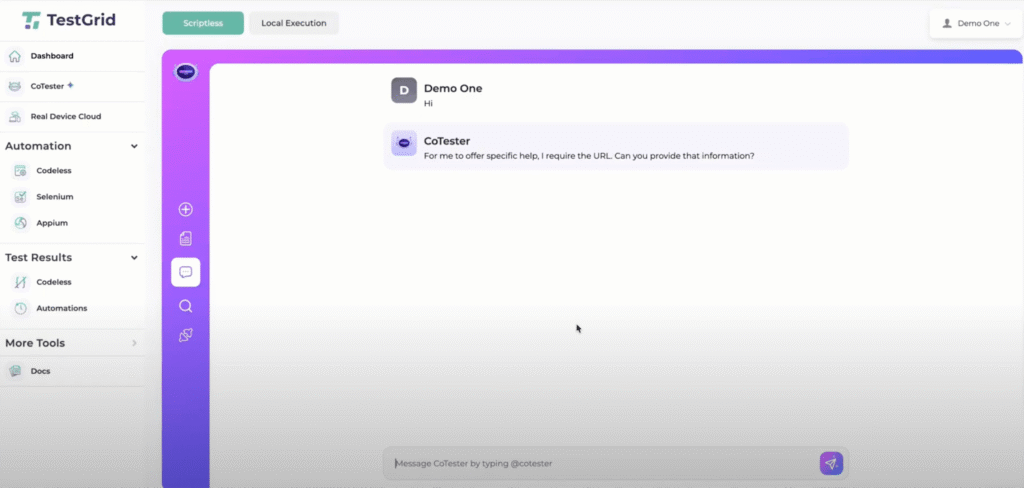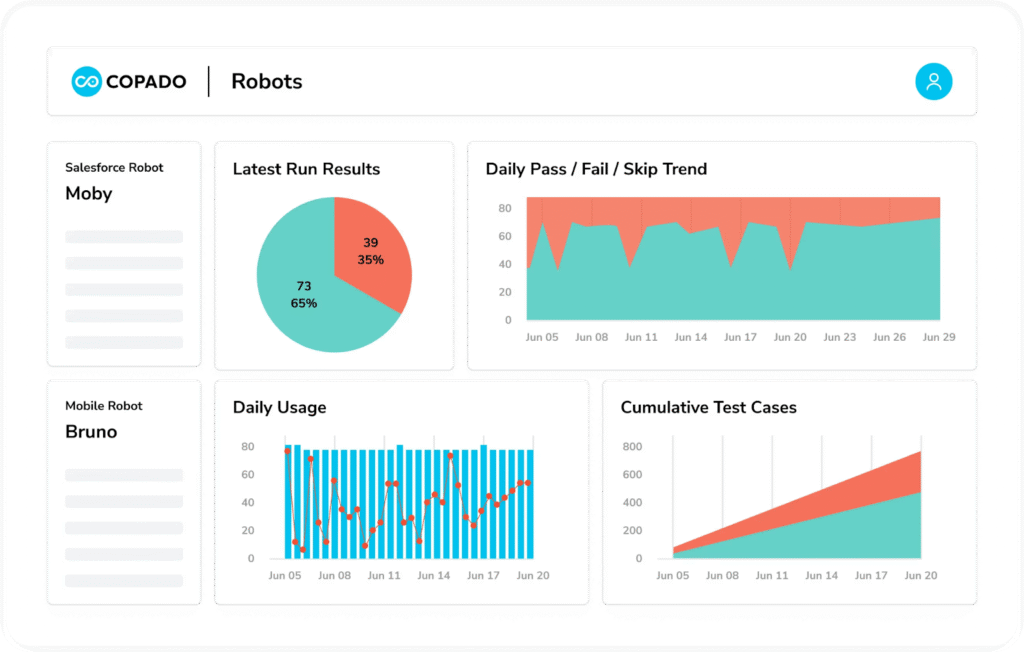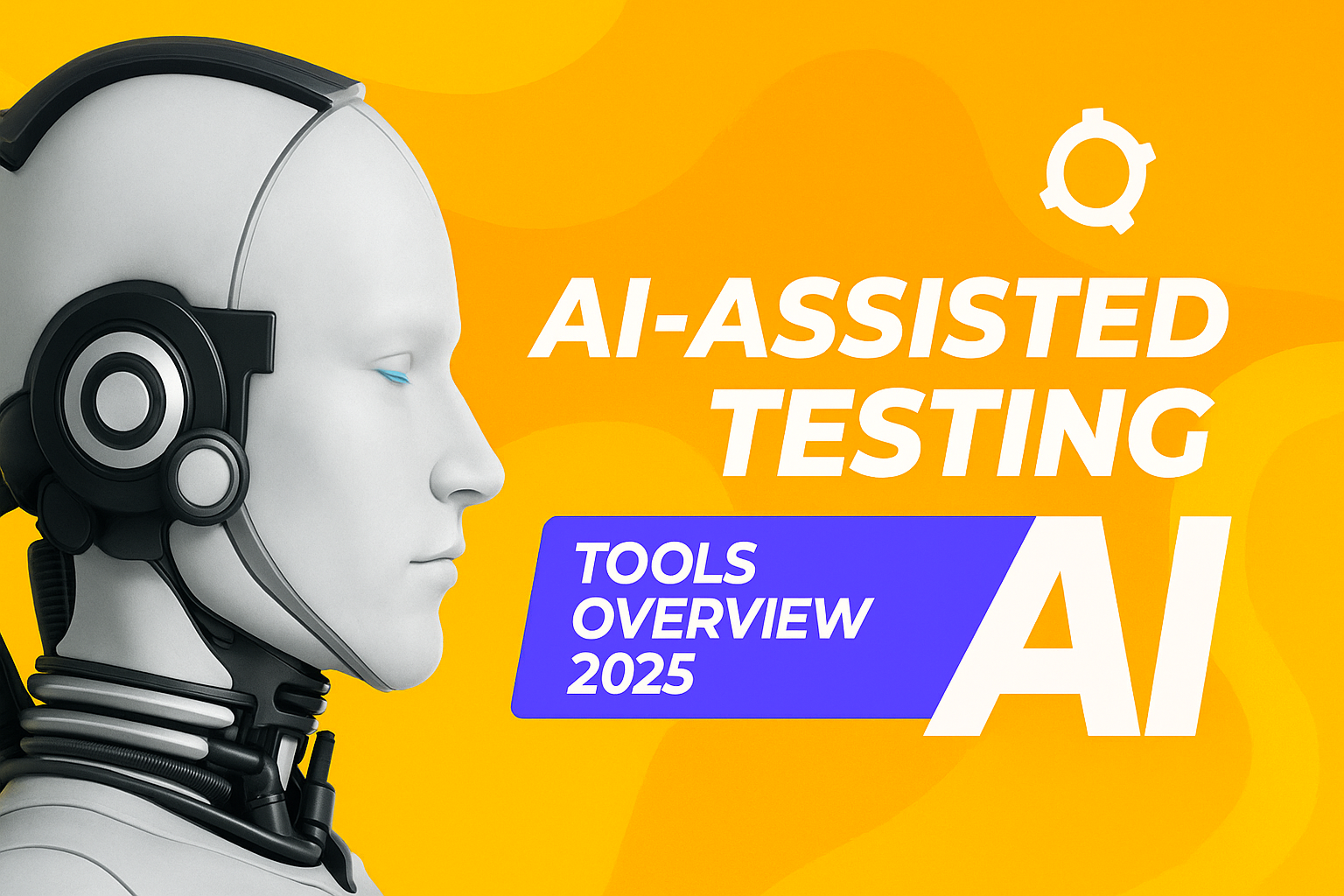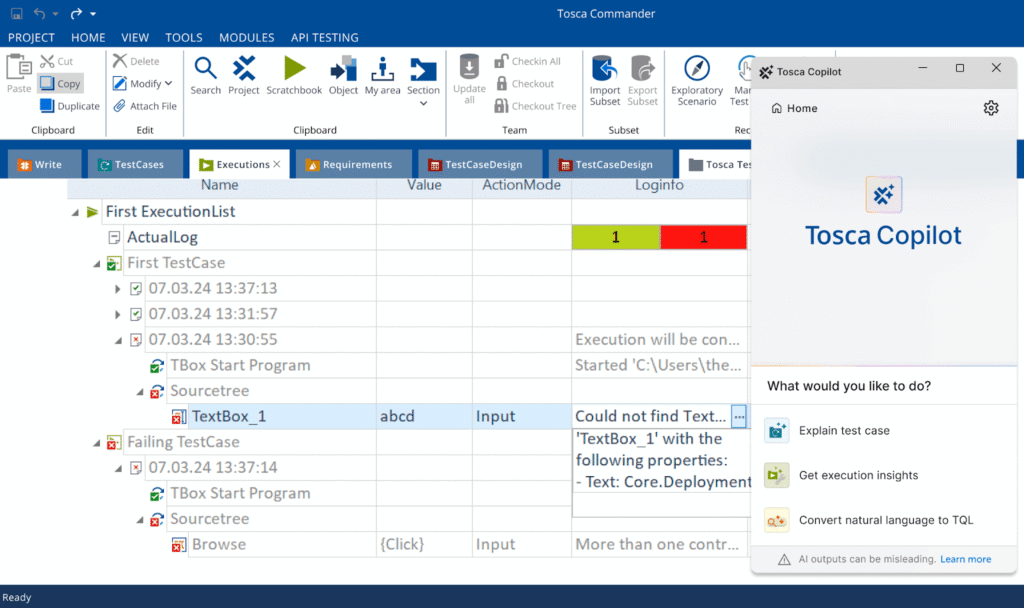AI-Assisted Testing: Tool Overview for 2025
Artificial intelligence is rapidly transforming software testing. In this article, we explore the top AI testing tools in 2025 and analyze which platforms truly deliver value.
CoTester by TestGrid: AI Testing Tool Built for Usability
CoTester is an AI-based solution specifically designed around the principles of software testing and the software development life cycle (SDLC). Unlike conventional tools, it allows testers to interact in natural language — if you want, you can start by simply typing „Hello” and begin the process instantly.

The platform offers two training options: uploading documents such as PDFs, Word files, or CSVs that contain user stories, or providing URLs for automated analysis.
Once the training data is ingested, CoTester produces highly contextual test cases aligned with business logic and this includes an integrated debugger that enables users to immediately review generated test cases, view logs, and analyze screenshots.
In real-world e-commerce use cases, CoTester excels with user input forms and purchase workflows. For example in case when you providing the URL of a registration form, the system automatically evaluates the field structure and generates test cases that cover input validation, length constraints, and boundary conditions.
What sets CoTester apart is its ability to interpret intent rather than rely on rigid commands. Thanks to genuine AI capabilities, it demonstrates superior understanding of business context compared to traditional testing tools — resulting in more relevant and thoughtful test coverage.
Currently, CoTester supports web applications. However, mobile testing support and integrations with platforms like Jira, Slack, and Microsoft Teams are on the product roadmap and expected to roll out within the year.
Learn more about CoTester on TestGrid
ce=”1 1 []”>Testim Copilot: JavaScript-Driven AI Testing Tool
Testim Copilot offers a distinct approach by focusing on generating JavaScript code for test steps, making it especially appealing for development-driven QA teams.

Key capabilities include:
- Analyzing existing test cases and recommending optimizations
- Automatically fixing buggy code with clear reasoning
- Supporting machine-learning-powered locators across mobile platforms
Testim Copilot excels at generating complex assertions and managing difficult UI flows, especially in Single Page Applications (SPAs) where conventional element targeting often fails so it assumes a solid understanding of JavaScript, which may limit accessibility for non-technical testers. Additionally, the generated code frequently needs tailoring to match the team’s testing framework.
Mabl AI: Visual Regression Leader Among AI Testing Tools
Mabl AI leverages computer vision to track and evaluate UI changes, making it a strong choice for visual regression testing.
Core features include:
- Proactively detecting unstable or flaky tests
- Adapting automatically to changing selectors using expert system logic
- Grouping accessibility issues by page for better prioritization
- Tracking load and execution time with trend visualization
Mabl is particularly helpful in fast-paced frontend development environments. It can catch subtle UI style changes — such as color contrast shifts because of that may affect accessibility, and even suggests WCAG-compliant alternatives.
It also introduces a smarter approach to test timing: rather than using fixed timeouts and it learns application-specific behaviors to reduce false negatives due to slow environments.
However, Mabl lacks the flexible test-editing interface found in CoTester, and some of its advanced visual features require additional configuration.
aqua AI: Multilingual and Visual-Driven AI Testing
aqua AI stands out with its support for multilingual teams and its ability to generate tests directly from images or UML diagrams.

Key advantages:
- Converts flowcharts and diagrams into comprehensive test cases that preserve paths and logic conditions
- Supports multiple European languages, including Italian, Polish, German, and French
- Refreshes parts of test suites without rebuilding the entire structure — perfect for iterative changes
- Uses a conversational interface to translate test ideas into full documentation
aqua AI is ideal for international teams working across language barriers. You can write in their native language, and the system produces consistent and unified test cases.
A particularly impressive feature is its ability to analyze rough UI sketches — even hand-drawn ones — and automatically detect interface elements to propose matching test scenarios.
On the downside, aqua AI isn’t as precise as some competitors when it comes to generating tests based on real user stories, especially in complex business workflows.
Kane AI: Self-Healing and Cross-Platform AI Testing Tool

Built on large language models, Kane AI delivers robust self-healing capabilities that enhance test reliability.
Primary features:
- Generates end-to-end tests for both web and mobile applications
- Converts manual tests into automation scripts with minimal human intervention
- Maintains test resilience through advanced recovery mechanisms
- Runs tests across 3,000+ combinations of devices, browsers, and operating systems
Kane AI is well-suited for environments with frequent UI changes, as it adapts intelligently where traditional tests often fail. Moreover, its flexible engine ensures reliability even during constant UI shifts, reducing maintenance overhead. It also offers „bulletproof” test generation, transforming user interactions into readable, natural-language scripts that simplify maintenance.
Additionally, it enables seamless translation of tests between frameworks like Selenium, Java, Cypress, and Playwright. This is ideal for teams switching between tech stacks.
However, it currently lacks the deeper integration with organizational tools and analytics that CoTester provides.
Tosca Copilot
Tightly integrated with the Tosca platform, Tosca Copilot focuses on test suite optimization and analysis.
Key strengths:
- Identifies unused or duplicate test cases
- Converts plain questions into complex Tosca Query Language (TQL) queries
- Summarizes long test cases and steps
- Offers 24/7 assistance through built-in bots
It’s particularly effective in enterprise environments with massive test libraries, where optimizing redundancy can yield significant efficiency gains.
Testsigma Copilot

Notable features:
- Automatically generates API tests from JSON data
- Recommends intelligent test data tailored to business context
- Builds custom test data profiles using user-defined queries
- Stabilizes tests through element remapping
Testsigma Copilot is especially strong in API testing. It can generate robust test suites that cover edge cases and error-handling logic with little manual effort.
Although it’s less flexible than standalone tools like CoTester, it offers deep platform integration that benefits teams already using the Testsigma ecosystem.
Copado Robotic Testing
Aimed at Salesforce and nCino ecosystems, Copado Robotic Testing includes ready-made keyword libraries specific to these platforms.

Top benefits:
- Supports no-code, low-code, and pro-code scripting
- Converts manual cases into accurate automated scripts
- Flags regressions and shares results across teams
- Requires no software installation or infrastructure maintenance
During Salesforce-to-Lightning migrations, Copado excels by understanding platform-specific nuances. Its QWords libraries for nCino, CPQ, and ServiceMax ensure stability even when UI elements change significantly.
It’s also tightly integrated with Salesforce’s release cycle, automatically detecting configuration changes and recommending relevant test updates.
However, Copado’s narrow focus makes it less useful for organizations outside the Salesforce ecosystem.
Pricing Overview
- CoTester: free tier (200 minutes), paid plans from $25/month, with enterprise options
- Testim Copilot: custom pricing based on deployment needs
- Mabl AI: 14-day free trial, followed by tailored plans
- aqua AI Copilot: currently free in open beta for cloud users
- Kane AI: in beta, pricing available upon request
- Tosca Copilot: bundled with Tosca, not sold separately
- Testsigma Copilot: part of Enterprise plan
- Copado Robotic Testing: varies based on Salesforce implementation scale
In terms of total cost of ownership (TCO), platform-integrated tools like Tosca offer a lower barrier to entry but less flexibility. Independent tools like CoTester and Kane AI may cost more upfront but often deliver higher ROI through long-term adaptability.
Use Case Highlights
- E-commerce apps with frequent UI changes → Mabl AI, Kane AI
- Salesforce-based platforms → Copado Robotic Testing
- QA teams with minimal programming skills → CoTester, aqua AI
- Complex APIs and business logic → Testsigma Copilot, Testim Copilot
- Extensive, redundant test libraries → Tosca Copilot
Key Evaluation Criteria
- Cost-effectiveness: consider time and resource savings, not just licensing fees
- Integration: ensure compatibility with CI/CD tools, code repositories, project management platforms</li>
- Industry alignment: check for domain-specific features (e.g., finance, healthcare, e-commerce)
- <strong
- >Ease of adoption: some tools (e.g., CoTester) require <1 week to get started, others (e.g., Testim) may need several weeks
- Scalability: assess if the tool works equally well at 100 or 10,000+ test cases
- Data privacy: tools like CoTester offer organizational data isolation, crucial for regulated industries
Conclusion
After extensive evaluation, CoTester stands out as the most versatile tool for teams with mixed technical experience. Its intuitive UI and multi-source test generation provide an excellent balance between accessibility and functionality.
Testim Copilot is best for developer-heavy teams that need deep scripting flexibility, while Copado Robotic Testing is a natural choice for Salesforce-driven environments.
Mabl AI excels in visual regression testing, Kane AI in mobile self-healing automation, Tosca Copilot in test portfolio optimization, and Testsigma Copilot in comprehensive API testing.
As the AI testing market evolves, it’s crucial to assess not just current features but also the vendor’s roadmap and long-term support strategy.
I will work with Cotester to see if working with such tools can effectively relieve the burden of testing and whether it will not cause „backwardness” and forgetting basic tester activities. I am afraid that using such tools that relieve dozens of percent of engaging your own mind may result in a lack of competitiveness on the job market due to lack of basic skills. If you are just starting work as a software tester, these tools are certainly not for you – first focus on your own learning to use AI tools, there will be time later…
Source:<a style=”color: #999999;” href=”https://testgrid.io/blog/cotester-vs-other-agentic-ai-platforms-for-testing/”> https://testgrid.io/blog/cotester-vs-other-agentic-ai-platforms-for-testing/
editor's pick
latest video
news via inbox
Nulla turp dis cursus. Integer liberos euismod pretium faucibua






